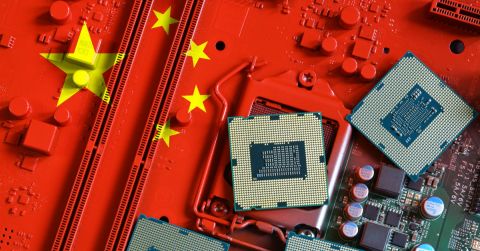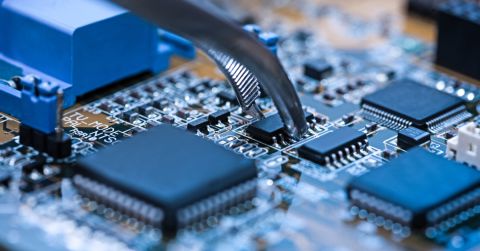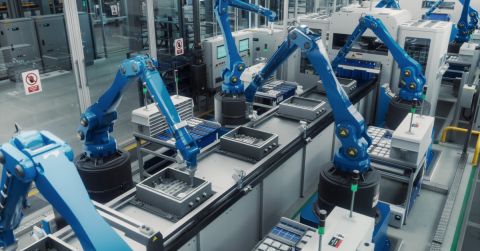Decarbonizing Industry: AtmosZero's Game-Changing Technology Explained

AtmosZero is revolutionizing industrial decarbonization with cutting-edge steam-generating heat pumps. In this episode of the CTRL+Listen Podcast, host James Sweetlove sits down with Ashwin Salvi, co-founder and Chief Commercial Officer at AtmosZero, to discuss how his company is tackling the hard-to-decarbonize industrial sector. AtmosZero’s technology focuses on creating carbon-free steam for industries like manufacturing, food & beverage, and pharmaceuticals—all major sources of emissions.
Traditional fossil-fuel-powered boilers are difficult to replace, but AtmosZero offers a modular, efficient, and electrified alternative, designed to seamlessly integrate into existing systems and reduce carbon footprints. Ashwin also shares insights into global energy policies, the future of climate tech, and AtmosZero's exciting partnership with New Belgium Brewing to create decarbonized beer. Tune in to learn how AtmosZero is bringing us closer to a carbon-neutral future, one ton of steam at a time.
Listen to the Episode:
Watch the Episode:
Key Moments:
- What is Industrial Decarbonization?
- The Difference Between Boiler 2.0 & Standard?
- Scalability/Plug-and-Play?
- Steam Tech
- How Achievable are our Climate Goals?
Links:
Find out more about Atmoszero here
Connect with Ashwin here
Transcript:
James: Hi, everyone, this is James from the "Ctrl+Listen Podcast" brought to you by Octopart. Today, I have with me Ashwin Salvi. He is from a company called AtmosZero. He's the global head of Business Development and the co-founder of the company. Thank you so much, Ashwin, for coming on the show. It's great to talk to you.
Ashwin: Hey, James. Thanks for having me here. And hello, podcast listeners.
James: Welcome. Just to start, I guess, do you wanna maybe tell us a little bit about yourself and a bit about what you do at the company?
Ashwin: Yeah, sure. So I'm Ashwin Salvi, like you mentioned, co-founder and chief commercial officer for AtmosZero, got a background in mechanical engineering and I've been doing climate tech kinda work for almost 20 years now.
James: Wow. I'm gonna get into this later, but I do have a question about how it's changed over that 20 years. To start, I guess, we should probably learn a bit about the company. Do you wanna tell us a bit about what the company does?
Ashwin: Sure. And there's been a lot of change in the last 20 years. I'm happy to talk about that.
James: Great.
Ashwin AtmosZero, what we do is focus on decarbonizing hard to decarbonize sectors. Specifically, we focus on the industrial sector. We make steam-generating heat pumps, because industry itself is a large, large emitter of emissions and it's been notoriously hard to decarbonize 'cause you can't just take the process that makes food and decarbonize that and have that scale to something that makes chemicals, right?
James:Right.
Ashwin: But the real unifying thread there is heat and, in particular, steam. If you can decarbonize steam, you can decarbonize, you know, more than two gigatons of CO2 emissions per year. It's huge opportunity.
James: Wow.
Ashwin: And what we're doing is focusing on a technology that can be standardized and scalable so that we can deploy very quickly and, in large numbers, technology that can rapidly help decarbonize the industrial sector.
James: Oh, that's awesome. Very exciting stuff. Do you see this sort of like an untapped market, something it's been there this whole time and we just didn't think about really, you know, harnessing it?
Ashwin: That's a great question. So in the industrial sector, and when I speak about industrial sectors, we're talking about, like, manufacturing. We're talking about pulp and paper, food and beverage. And that could be like breweries, meat packing, chemicals, pharmaceuticals, all these kinds of things that touch your life every day. Like to the beer you drink, to the toothpaste that hopefully you use this morning. It's all touched by steam effectively. Industrial heat, right? And so there's been opportunities that we've looked at before to be able to decarbonize, you know, various spots of heat here and there, but it's never really been kind of a unified approach. It's always been kinda custom-engineered solution here, custom-engineered solution there, maybe it depends a little bit too much on local economics. There's never been kind of like this standard boiler. You know, today's boilers are just something you can buy and comes with a standard spec. They can just install with the same connections and the same outputs. It's always been a little bit here and there. We're working on making a standard boiler but without any onsite emissions and ultra-high efficiency that can be electrified and really make these technologies cost competitive with today's technology.
James: Oh, that's very exciting. I guess before we get too deep into it, you should maybe explain what industrial decarbonization is.
Ashwin: Yeah, yeah. Like I mentioned, you know, the industrial side, you know, there's so many different processes that exist, but there's so much of it that depends on heat. They need heat to do something, altering chemical states or physical states. And heat is best transferred by steam. There's a lot of energy density in steam because you're taking water from liquid form, making it into a vapor, and using that to really bring things like large kettles of liquid up to a boil very quickly, which is important into manufacturing times. And so when I speak about industrial decarbonization, I'm speaking specifically on the heat side 'cause that's what we're focused on as a large untapped potential, there's obviously other sides to it too. And the way that I'm talking about it is how do I eliminate point source emissions from manufacturing facilities that have carbon but also things like NOx or SOx that help reduce the local air quality impact from combustion onsite?
James: It's interesting. We had a guest a while back who did something similar, not with boilers though, but it was basically some panels that you could put into your combustion-based equipment, I guess, that saved or stored or created 30% more energy from the existing, you know, combustion reaction. So it's interesting that this company's springing up in a bunch of different industrial areas, and including yours, who are saying, "Hey, we don't have to reinvent the wheel, we can just make the wheel infinitely more efficient while we figure out renewable energy side of things."
Ashwin: You know, I love that you said that because when we started AtmosZero, you know, back in 2022, we're not here trying to be perpetually in an R&D world. We're working on things that can scale into industry and into customers' hands as quickly as possible so that we can have near-term real world impacts like right now, right? You know, so within starting the company two and a half years ago, we're actually gonna have our first commercial product out the door in just a few months from now, in March of 2025. And that's just showing you exactly, like, the focus that we approach this problem with, saying, "We're gonna leverage as much, like, supply chain and establish industry as possible, invent a couple things that enable our tech so that, you know, we can actually get it out in the market to do things that other people can't do and really put this out in the field." So I really liked that perspective of like, "Let's not reinvent the wheel, let's get the wheels on the road."
James: Yeah, exactly. It's just you have this existing infrastructure, which you can use to make a huge impact in, you know, fighting climate change, why not harness it while we do the other work in the background?
Ashwin: That's exactly right.
James: Yeah. So I guess what's the difference between Boiler 2.0 and a standard boiler?
Ashwin: Yeah, yeah. So, you know, standard boilers today, it's those fossil-fired assets. So, you know, predominantly in the US it's natural gas. Some places overseas it can still be using liquid fuels or even coal. They're burning a fossil fuel ultimately to make water hot and convert that into steam. Then they use that steam somewhere in their manufacturing process, sterilization, boiling, whatever it is, to do something else useful with it, right? It's really that formation of steam that we're focused on. And instead of burning a fossil fuel, we actually have a heat pump-based solution that takes heat from a heat source, whether that's air or whether that's water, and uses electricity to upgrade that heat to then use that heat to make steam, use that heat to boil water into steam, and use that steam the same exact way that you're using it with fossil-fired boilers today. Nothing in your process or facility has to change. I literally just plug my steam into your process and it works the same exact way. The thing that we're doing is eliminating the consumption of onsite fossil fuels and eliminating the process of making onsite emissions because now we're an electrified solution. And by using a heat pump solution, we're super, super high efficiency. For example, today's natural gas boilers have a huge range of efficiency. Some people advertise 90% efficiency. We've measured things in the field around 60%. Our solution can be upwards of 200% efficient, because we're sourcing heat from somewhere. So we pay for one unit of energy in, we get two units of energy out because the other unit of energy is coming from air or water and that's effectively for free. We're not paying for that.
James: Right, right. It's also neutral.
Ashwin: That's exactly right.
James: Yeah. What's sort of the cost of this boiler compared to standard market boiler?
Ashwin: Yeah, it's interesting that you say that, right, because if you're talking to customers today that are trying to decarbonize, your real solution, the only real commercially viable solution today, is an electric-resistive or electrode boiler. So going back to that example of, you know, you pay for one unit of energy in, you get two units of energy out for my heat pump, traditional boilers you pay for, you know, one unit of energy in, you get 0.85 units of heat out. Electric boilers are more efficient. Electric-resistive boilers are more efficient. One unit of energy in, one unit of heat out roughly. But that means you're paying electrical prices instead of natural gas prices. So your cost is rather high to operate.
James: Right.
Ashwin: That being said, these technologies are actually making market traction. There's lots of out there deploying electric-resistive boilers right now to help them decarbonize the manufacturing process. If instead of that you use our technology, we're talking about payback periods of less than two to three years, right, because of how efficient our technology is.
James: I guess that kinda leads me to another question. So what's sort of like the scalability or plug and play potential for something like this?
Ashwin: Yeah, yeah. So, you know, what I like to say is we're exactly like the boilers you're used to today, the only thing that changes is your energy input. So instead of a liquid fuel or like natural gas as an energy source that you burn, we just change that for electricity and all the connections to the system are all the same. So traditional boilers today, they all use water as something that they converted to steam. So we would use that same exact water, we call that boiler feed water, and use our device to convert that boiler feed water into steam and that's the output from our system just like it is for traditional boilers. And that steam just has a flange that connects to the rest of the system in your building. So typically you might have one, two, et cetera boilers all making steam, tying it into a common steam header. And from that header, that steam goes into your production facility. It does something useful, right?
James: Right.
Ashwin: We will just tie in that same exact header and let that steam go into the same end users as it is. So we can tie in actually in parallel with existing assets if you want some sort of redundancy, or if you wanna decarbonize X fraction of your steam, or we could fully replace all of your existing boilers as it is.
James: Interesting. That was actually gonna be my next question. So, okay, that's great. I mean, it works just as well with an existing system as it does installed from scratch and into construction process.
Ashwin: Yeah, you know, what we're seeing is certainly a great application for retrofit. What we do is really streamline that. We don't have to interfere with the building's processes, or with your proprietary process, or even have you adjust any process conditions. We literally just tie it in, and there's no change in your manufacturing operations whatsoever. If you look at new builds, we can absolutely do that too. As an example case, if you're a manufacturing process that maybe doesn't have access to steady state sources of heat, like a source of hot water or something like that, we can use our air source component and pull heat from ambient air, which is always steady. Or we could also, you know, liquid source it if you have that available. Ultimately, the point is this: if you're trying to decarbonize, steam-generating heat pumps, AtmosZero steam-generating heat pump, is something that's most cost effective way of doing so.
James: Interesting. So for someone who doesn't know a huge amount about boilers, what's the sort of size or range of something like this? So for an industrial output, is it immensely larger than something like a small factory setting or is it just multiple of the same unit that you use to achieve the same goal?
Ashwin: Oh, that's a fantastic question. So the whole idea is, again, we're modular, right? So if one of our units, you know, footprint's 8 foot wide, 20 feet long, kinda like a standard shipping container, that makes 2,000 pounds of steam per hour. So one ton of steam per hour. That's great for like small to mid-sized factories. If you need more than 2,000 pounds of steam per hour, you would just add a second one or a third one in parallel. These things all feed a common header. That's exactly what you see in industry today. They have multiple boilers all making steam that just tie into a common header. We have exactly the same principle. That's our first product. We will be making different products in the future, likely a larger system in a few years from now.
James: Wow, there you go.
Ashwin: Yeah.
James: You and I talked about... Oh, sorry, go ahead.
Ashwin: I was just gonna say, going back to what I said earlier about why we're more cost effective. We talked about, again, the efficiency of our system and why that's so much higher than conventional boilers because we're able to leverage thermodynamics to really be leveraging sources of heat and upgrading that heat instead of creating that heat from scratch, right?
James: Right.
Ashwin: The other aspect of why we're more cost effective, and this kinda ties into what I just mentioned, is the integration effort. We don't need to shut down facilities for an extended period of time to install our system. We don't have to shut down facilities to be able to go and get hot sources of waste heat to be able to drive our system, right? That ends up being really these custom-engineered solutions that end up just costing a lot of time and money to implement. And worse than that is if you, you know, most facilities... Companies have more than one facility in the world. So if you're doing this intensive thing at one location and you're like, "Okay, great, let me go do a second one," guess what, that second location is almost always different from the first one. So now you gotta go back and do all this custom-engineering again to be able to decarbonize that location. That makes it really slow and costly. We solved that by just creating this modular plug and play solution.
James: Yeah, I've noticed quite a few companies are doing that and I think those are the ones that are gonna roll out an impactful change the fastest just because it's so scalable, as you mentioned earlier.
Ashwin: Get those wheels on the road.
James: Yeah, exactly. You and I were talking about something briefly before we started recording, which was how has, I guess, steam tech progressed over the past few decades?
Ashwin: Yeah, that's really funny. Honestly, since the Industrial Revolution, it's all been the same. Sure things have gotten safer, right? Now you have less boilers exploding, knock on wood, right? But, generally, the principle is the same. You're converting a fossil asset from, you know, thermal heat into boiling water and making steam outta that. And, again, using that steam to do something useful with it. But that process, it's been roughly the same for almost 200 now. There hasn't been a change in that until things like a steam-generating heat pump come along.
James: Right.
Ashwin: We're changing the fundamental process of how do you make that steam and, more importantly, changing the efficiency at which you do that.
James: Do you think steam's gonna continue to be around as long as we're around basically?
Ashwin: Absolutely. There's so many processes in the manufacturing world, and even in, like, the commercial, the built environment world that needs steam for heat transfer. You know, one of the advantages of steam is that it's so energy-dense that you can use a lot smaller piping in your facility as opposed to converting over to, like, hot water. You need to increase your pipe size to do that 'cause your energy density is just lower. There's so many processes, things like sterilization or things like bringing things up to a boil, which you just need high temperature for that you can't get away from. Sure you'll get some competing trends or competing technologies out there that are converting. So university campuses, from district steam, you know, generally university campuses have this central steam plant, make steam, put it into underground networks and go into end users like buildings around campus, that could convert to hot water because ultimately you just really need that for heating of ambient spaces. But there's facilities in those campuses like life science buildings or hospital buildings that will always still need steam. And so you need to be able to do that in a cost effective way and also be able to reduce the carbon signature of that steam.
James: Right. I might be wrong with this, but I'm sure you know. Steam can also be used as like a heating system in itself, right? Like running underneath buildings or like through buildings?
Ashwin: That's exactly right. So if you've ever been in New York and you've walked through the streets, you've seen the steam coming out. That's exactly what that is. That is a steam network underground that goes into apartment buildings, office buildings, and goes to steam risers that now provides space heating. Or, you know, in some places, it can be exchanged for hot water or even process steam for some of the industrials there that could use it for manufacturing or sterilization.
James: So could a system like that also take advantage of your technology?
Ashwin: Absolutely. Anyone that needs steam, we can go in there and help create that steam in a decarbonized fashion.
James:That's great. That's so applicable.
Ashwin: It's so wild when you really dig into this. And, you know, this world has existed for many, many decades. But the more and more you dig into it and you realize how much steam actually impacts our life, like these clothes, right? I ironed this shirt, that was steam. Of course I'm not gonna make a heat pump-powered iron. But, you know, like textiles, you know, metals and plastic, et cetera, all need process heat and typically that's steam.
James: Right. I've had guests talking about sensor technology. It's one of those things that's in your everyday life but you don't think about or appreciate it.
Ashwin: That's right. And the range of steam is also, you know, the range of heat in the industrial sector, it's pretty varied. We focus solely on, like, the 100 Celsius to 200 Celsius range. This temperature range is like very applicable to that food and beverage, chemicals, pulp and paper types of industries. That accounts for roughly 50% of industrial heat need, just that 100 degree range. That's what lets us be able to create a standardized product, 'cause our window is just like, "We're focused on this temperature range," because now we can make something that can scale various different industries and, more importantly, also scale, you know, from different continents, right? We're based in the US, we're based in Colorado, but we also have a subsidiary in the EU and the Netherlands because we see this being a global challenge, right? You have manufacturing all over the world and they all need a way of cost effectively decarbonizing that manufacturing facility. We're focused on that. But, you know, getting back to the metal example, a lot of these kinda heat needs are much, much higher at temperatures. We're talking about, you know, 1,500 and thereabouts. We're not gonna touch that temperature range with our heat pump. When you get to that high temperature, efficiencies will drop off quite a bit where it doesn't really make sense. We're focused solely on that kinda low to medium temperature or pressure steam.
James: Okay, that makes sense. So you actually just made me think of a question. So what differences have you noticed between the US and the EU in regards to renewable energy and technology such as this?
Ashwin: Oh, boy. I wonder how much I wanna step in with my answer here. You know, the US benefits a lot from really low cost of energy. Low cost of natural gas all throughout the US. We have access to that on site and so that can keep prices pretty low. When you go to other parts of the world, and let's just talk about the EU 'cause that's where we're based, energy is different priced because they have different, let's call it externalities included or call it carbon pricing, right? Europe has something called the ETS, Emissions Trading Scheme, that puts effectively a price on carbon for industries that says, "If you're gonna emit over a certain amount of money, you need to pay this much amount of money per ton of carbon that you emit." They also have things like the Carbon Border Adjustment Mechanism, CBAM for short. That helps to, like, say, "Okay, because we're implementing the ETS, manufacturers might find a more economical goal, you know, overseas somewhere and make steam, or make products with dirty energy and import that over." CBAM is helping to adjust for the carbon signature of the things you're importing into Europe just so that you can create more of a even and fair playing field. So, you know, you look at other countries and their energy pricing is very different from the US, and they're actually different from other countries to other countries too, and different policies that can be driving that energy pricing and it's a world of opportunity everywhere.
James: Yeah, I can tell you, New Zealand and Australia's energy pricing is very different to the US. I experienced that for many years. It's a relief coming here.
Ashwin: Yeah, yeah, yeah, for sure.
James:So how have global supply chains affected your company and what you're trying to do?
Ashwin: Also, another great question. You know, one of the things, and the reasons that we can get to market so quickly is because, you know, we're leveraging a huge fraction of established supply chain products for our product. You know, for example, a heat exchanger or a valve, I don't need to reinvent that, right? These things exist for both the residential, commercial, industrial side of things. I don't need to go in there and just tune something just for my product. That now creates a whole new part number and a whole new manufacturing process.
James: Right.
Ashwin: I can, and I could maybe get some advantage out of doing that, but our whole point is speed to market and being able to get, again, these devices on the road that have good reliability, that have good availability of spare parts by using standard products. You know, we can just go and get a replacement part fairly easily from our vendors. And more importantly, we can have multiple vendors, multiple sources of these parts so that if, say, one vendor from a certain part of the world loses access to something, we can go and buy a replacement part from someone else. That way we're not subject to a lot of the supply chain constraints that could exist. Sure there's some other things like we're an electrified solution, right? Getting electrical power capacity at certain locations might take a little bit more time if we have to upgrade local transformers or switch gears.
James: Right.
Ashwin: Man, I'll tell you what, you give me a switch gear or a transformer in less than, like, 12 months, we're gonna be best friends. So that's just gonna be a challenge in general with electrification, because of the demand of things like data centers or those kinds of heavy consumers.
James: Interesting. So we're kinda coming to the end of the questions. I had one I wanted to make sure I asked, which was do you see technology in this space changing a great deal in the coming years?
Ashwin: Yeah, yeah. Actually, so this kinda goes back to what we talked about in the beginning of that conversation. I've been doing this for almost 20 years now, right? And I used to work at Department of Energy, at ARPA-E. I got to see a lot of amazing technologies then. But really just to see the traction the last couple years, especially with things like the IRA, like all the government funding coming out in the US side, has really spurred innovation but, more importantly, deployment and adoption. Now, going back to it again, like yes, we absolutely need to keep doing research on new technologies moving us forward, things that are applicable 10, 20, 30 years down the road. But we need to be focusing also on deploying things right now so we can have tangible results right now. And I'm starting to see a lot of, not just innovators or companies focusing on that, but also, like, consumers, customers that are buying these products, actually putting money where their mouth is. Like, you know, in just the last year or two, a lot of people went from talking about stuff to deploying. There's a lot of new case studies out there. A lot of people have goals for 2030. And guess what, it's almost 2025, people need to start acting to make that goal feasible. That's the biggest change I've seen, is people are actually starting to stick to this. Not just like a domestic thing, it's not like a one-off, like California's off doing California things, it's a global thing, right? People are really starting to pay attention. Companies have footprints all over the world and they're all making every one of these companies all over the world follow decarbonization strategies. I love that.
James: No, me too. I think Europe's been kind of a guiding light for that for a while now. The legislation's been pretty far ahead of a lot of other regions.
Ashwin: Yeah, yeah. I mean, I love that. What I'm also seeing is sometimes it's not even legislation-driven, sometimes it's just company like, you know, board of directors or C-suite mandated like, "We're gonna do the right thing here." Sure it needs to come down to economics as well, but I've talked to a number of customers, or sorry, yeah, customers that aren't being driven to do this by legislation but by their own, like, internal alignment.
James: No, that's awesome. I'd love to see that. So there's a cultural shift basically is what you're saying.
Ashwin: That's a simpler way of saying it, exactly.
James: And I have to ask you before we end, 'cause I meant to ask it earlier. You mentioned you have your first real product rolling out next year, do you wanna tell us a little bit more about that and what you can say, I guess, in that space?
Ashwin: Yeah, yeah, for sure. If you've been following into the US AtmosZero, I'm happy to say that, you know, our first customer, New Belgium Brewing is taking our product, this 2,000 pounds of steam per hour device, and installing it in their brewing facility in Fort Collins, Colorado as a pilot product. Pilot project. That's going live in March roughly, 2025. We're gonna be putting it in the field, making steam that's gonna be used in their kettles and in their processes just like their steam from their current boilers are. And I'm happy to say that by doing that they're gonna be able to start making decarbonized beer, something that I love, not the flat kind of course, like the kind that's low-carbon signature beer starting in just a few months from now. Super stoked about that. That's a public project. There's a number of other deployments coming up after that that are all over different sectors in different continents. So, you know, chemicals, food and beverage, et cetera, et cetera, et cetera, that we'll be deploying with that you'll just have to stay tuned for more public information on.
James: No, that's awesome. Really exciting. So last serious question. How achievable do you see our current climate goals with the rate that we're starting to finally change at?
Ashwin: Boy, that's a great question and I don't think I'm qualified enough to answer that. I'll just say this. There's a reason, you know, I got really into commercialization. You know, I did a PhD in mechanical engineering back in Michigan, Go Blue. The thing is like, that's fantastic, but what really got me excited is my time at Department of Energy when I was at ARPA-E, where I got to look at commercialization, right? Ultimately, your technology doesn't mean anything unless you can get it into the market in some form or fashion. And that's what I'm really excited about, because I personally don't think we have a lot of time to sit around and wait. I'm much more focused on getting things out the door and making real world impact. And that's why I'm grateful for partners like New Belgian Brewing because they help us with that part, prove our technology and then be able to scale that to a number of other customers. I don't know what this means for overall climate change at all. That's why I think it's all of the above kind of solution going forward. But I know that I can focus on getting something out the door quickly that can also be a long-lasting product, we're talking 20, 30, 40 years, so we can have just, you know, things that can go out tomorrow but still be making impact into the far future.
James: Right. I think companies like yours, and others like yours, are gonna be a big part of that change because I think there's some people that are, I guess, idealists who want to immediately switch to renewables 100%, which would be awesome, but also not very achievable. And then you have others who are hanging onto the fossil fuel side of things. But there are companies like yours who say, "Hey, look, obviously we need to make changes. How can we make as much change as possible within the existing systems?" And I think without that, it's not gonna happen.
Ashwin: Completely agreed. Case in point is this, right? My first few customers, we're talking about industrial heat decarbonization, we're talking about replacing traditional boilers, right? But what we're actually doing the next few months, sorry, first few customers, is deploying our asset in parallel with their existing boilers. So they get the redundancy or the de-risk capability of saying, "Okay, if this heat pump, you know, has issues or can't supply the steam I'm looking for, my manufacturing facility doesn't go down. I still have my boilers I can keep over here." You know, but the whole point is, "I can run the AtmosZero system and start making decarbonized steam and replace 50, 70% of my steam load from this system, get a huge amount of decarbonization while still being able to have the redundancy, if I need it, to be able to really understand this technology better and keep my manufacturing going at the same time." So it's not this like, "Day one, I'm getting rid of everything that you know and well understand. I'm saying I'm gonna start deploying this in steps so I can help my customers come with me in that process," at least splitting the difference, if you will.
James: Yeah, it's gradually phasing it out as opposed to just, in my opinion, from what I've seen, that works so much better because you have time to actually troubleshoot, see how it plays, see what changes you wanna make as you follow through their process.
Ashwin: While still giving them real credible scope on emissions reductions, like real onsite emissions reductions using our technology. Exactly.
James: Exactly, yep. Well, this has been a fascinating discussion. But for anyone who wants to follow along with the company, stay up to date with all these projects you're working on, what's the best place to do that?
Ashwin: You know, we've got a great social media presence on LinkedIn. Find us at AtmosZero on LinkedIn, come to our website, sign up for a newsletter. We have a newsletter distribution that goes out roughly quarterly at this point with all of our latest and greatest information from our team structure to projects, to future work that's going on, so. Or, you know, send me a note. I'm always happy to talk to people, find us in conferences, we'll always be around. So looking forward to hearing from you all.
James: Yeah, and, Ashwin, your LinkedIn and the company's socials will be dropped in the video description for the interview. So if anyone wants to reach out, they're more than welcome to.
Ashwin: Excellent. And thank you, James, for all the questions and insights.
James: Yeah, no, thank you for coming on. It's been really great chatting with you and we're excited to follow along with the company's journey.
Ashwin: Full steam ahead, if you will.
James: Steam ahead, great. And for anyone listening at home, just tune in next week, we'll have another guest for you.








